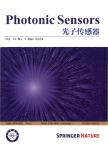Potential of SPR Sensors Based on Multilayer Interfaces With Gold and LHM for Biosensing Applications
Potential of SPR Sensors Based on Multilayer Interfaces With Gold and LHM for Biosensing Applications作者机构:University of Tlemcen Theoretical Physics Laboratory Physics of Department Tlemcen 13000 Algeria
出 版 物:《Photonic Sensors》 (光子传感器(英文版))
年 卷 期:2017年第7卷第3期
页 面:199-205页
核心收录:
学科分类:0831[工学-生物医学工程(可授工学、理学、医学学位)] 0711[理学-系统科学] 07[理学] 08[工学] 0803[工学-光学工程]
主 题:Plasmonic goos-Hhnchen (GH) effect SPR sensor systems sub-wavelength scale
摘 要:Recently, the subject on "plasmonics" has received significant attention in designing surface plasmon resonance (SPR) sensors. In order to achieve extremely high-sensitivity sensing, multilayered configurations based on a variety of active materials and dielectrics have been exploited. In this work, a novel SPR sensor is proposed and investigated theoretically. The structure, analyzed in attenuated total reflection (ATR), consists of multilayer interfaces between gold and a metamaterial (LHM) separated by an analyte layer as a sensing medium. By interchanging between gold and LHM, under the effect of the refractive index (RI) of analyte set to be in the range of 1.00 to 1.99, the sharp peak reflectivity at the SPR angle takes two opposite behaviors predicted from the transfer matrix method. At the threshold value of 1.568 of the refractive index of analyte and when the LHM is the outer medium, the layered structure exhibits a giant sharp peak located at 43° of intensity up to 105 due to the Goos-Hanchen effect. With respect to the refractive index (RI) change and thickness of analyte, the characteristics (intensity, resonance condition, and quality factor) of the SPR mode, which make the proposed device have the potential for biosensing applications, have been analytically modelized.



